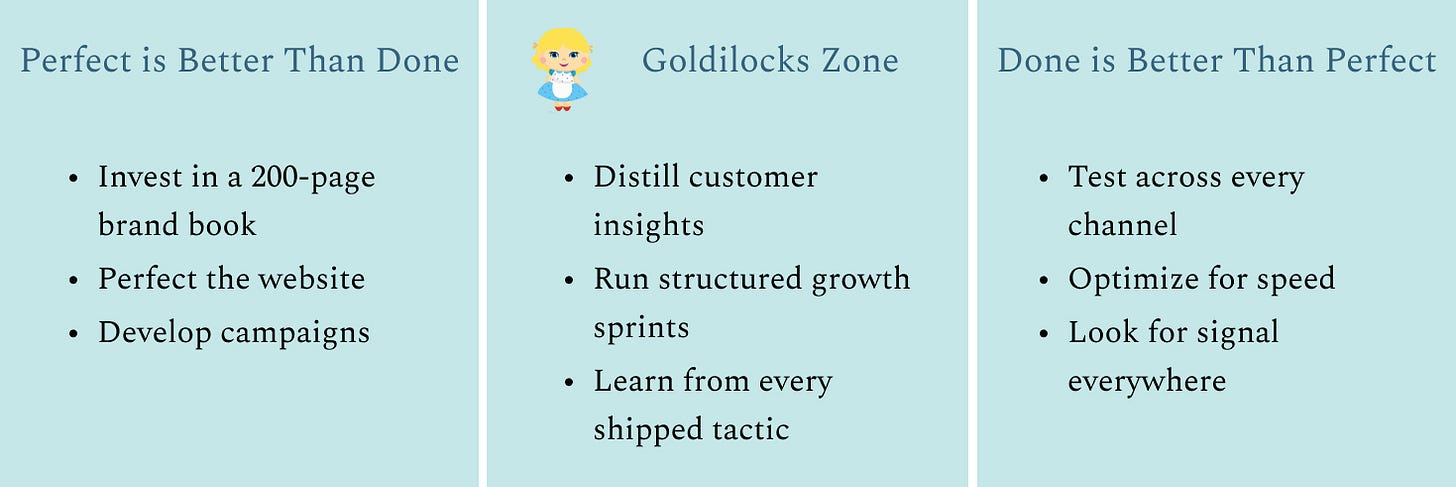Startup marketing is a deeply misunderstood function, especially by agencies used to managing established products within well-defined markets. Their tactics—say, creating a tome-like brand book—and expectations of starting with a crystal-clear understanding of value props won't be useful for all early-stage startups.
If you’re a founder or early-stage operator seeking a better way to acquire customers, please read on.
Aim for the Goldilocks zone, somewhere between developing a 200-page brand book and sending mailers to every address you can find. If you over-rotate too much on creating resonant content or testing a wide assortment of marketing tactics, you will waste a lot of time, energy, and money.
The same fundamental principle of a healthy marketing system at a scaling startup applies to early-stage: a balanced system across product, content, and growth marketing is what wins.
What’s different is that the early-stage version of this system is simpler and is optimized to help founders and early-stage teams learn about their customers and market as quickly as possible.
A healthy early-stage marketing system borrows 5 components from its later-stage counterpart:
🎯💬 Product marketing foundation to root your roadmap in customer insights
📊 Simple growth model to help you set goals and avoid vanity metrics
📣 Experiment roadmap rooted in customer behavior to structure and prioritize ideas for maximum impact
🏃♀️ Quick-cycle operating cadence to ensure you extract and act upon learnings
🗒 Non-intimidating briefing process to make sure the content you create resonates

What Most Founders Do
Early-stage startups all dabble in marketing from day one—whether it’s setting up a website, launching some initial Meta ads, or sourcing input from their LinkedIn community.
Once the product starts to get some traction within a customer segment, founders often look to bring on marketing support. That's the time to double down on your marketing engine.
At this point, founders often jump into hiring a marketing agency that isn't nimble enough or hiring a junior-level marketer who can execute but can't inform strategy. These can create impact, but only if there’s a clear sandbox for them to play in. Like, is there clarity on product positioning? Which channels should they focus on? (And have you communicated these points to them?) Plus, if these resources aren’t plugged into the founding team's ever-evolving thinking, they don’t stand a chance.
Ultimately, agencies and junior marketers alike waste a lot of money on ads that don’t work and end up throwing spaghetti at the wall to see what sticks. Fast-forward a few months to a lower bank account and disappointing new customer numbers.
What to Do Instead
First, take a moment to clarify your marketing strategy by putting these two components in place:
🎯💬Set up your product marketing foundation to root your roadmap in customer insights. At this point, you should have a sense of your initial ideal customer profile or at least a short list of hypotheses. Based on what you’ve heard from early customers, answer the following questions to define who the product is for, what value it offers, why it’s better than alternatives, and how to describe it to customers.
What are the core use cases or jobs-to-be-done our customers are hiring us for?
What are the alternative solutions for each, and why is ours more valuable?
What language are we using to describe this value to customers?
📊Create a simple growth model to help you set goals and avoid vanity metrics. Your growth model should cover how you acquire, retain, and monetize your customers and help to quantitatively connect marketing actions to business outcomes. You will use your growth model to understand:
What are our growth goals?
What is the #1 metric we need to unlock?
Which channels are likely to have the biggest impact on that metric?
Then invest in the process and structure to validate your strategy through experiments.
📣Build an experiment roadmap rooted in customer behavior to structure and prioritize ideas for maximum impact. An experiment is simply a marketing tactic used to learn about a hypothesis with a pre-defined goal that will be used to measure success. Your roadmap should start with beliefs you have about your customer and then outline different experiments you can use to validate your belief.
For example, let’s say you are selling a subscription to restock your products automatically:
Goal: Increase subscription rate from 15% to 18%
Hypothesis: "We believe that customers aren’t sure how often they’ll use products, making them hesitant to subscribe"
Experiment 1: Send an email campaign highlighting the ability to skip or delay items if they’re not ready for a restock
Experiment 2: Launch a quiz asking customers a few questions about their routine and making a recommendation on subscription frequency
Experiment 3: Highlight the ability to skip or delay items directly on the product landing page
Structuring your roadmap in this way ensures that you are also advancing your understanding of your customer and market and finding marketing tactics that work.As you’re building your roadmap, consider these questions:
What are our core beliefs (hypotheses) about our customers?
What are their pain points? What is the problem?
What natural triggers might lead them to our product?
What motivates them to seek help?
Why might they be skeptical about our product?
What are the different ways we can test those hypotheses?
Then, where should we start?
🏃♀️Quick-cycle operating cadence to ensure you extract and act upon learnings. Your operating cadence should focus on learning over results. It might seem counterintuitive at first, but the reality is, that getting marketing right on the first try rarely happens. The faster you learn, the faster you’ll get results.
How can we set up our experiments to avoid getting ambiguous results?
How will we extract learnings from each test?
How will we use what we have learned to re-prioritize our roadmap?
What rituals (e.g., meetings, dashboards, Slack channels) can we implement to speed up our learning?
🗒 Non-intimidating briefing process to make sure the content you create resonates. Non-intimidating = don't get bogged down by process, but focus on giving comprehensive, detailed information to your collaborators. You’re likely working with freelance content creators to create marketing assets. They have 5% or less of your context, so a briefing process ensures you are giving them all the info they need to create compelling content.
Who is this content for?
What is the key message?
Where is it being distributed?
How does it connect to our growth model?
If you want the template I use for each step, email me at libby@libbyweissman.com, and I’ll gladly share!
Learning from My Mistakes
My favorite growth analogy comes from Reforge: growth is a game of Battleship. The key to winning at Battleship (and marketing) is making the best guess possible based on all the information you have at a given moment.
It’s equally important to place your guesses correctly and to extract the right information from each guess.
Let me elaborate:

Think of every experiment launched as a pin in your Battleship board. You are making a guess about something you believe to be true about your customer and getting some information from the market to tell you if you are on the right track.
In Battleship, you start by taking shots at your opponent's ships, spread out across the board. In marketing, this is the same as validating the basics of your strategy (who the product is for, what value it offers, and why it’s better than alternatives).
Then as you learn more, you hone in on the areas of the board where the ships are most likely to be. In marketing, this is the same as starting to get a clear signal from one particular approach that you then double down on.
As the 1st marketing hire at Realm (a prop-tech marketplace helping homeowners navigate renovations), I was very focused on learning as quickly as possible and was launching dozens of experiments each week. Still, I made several mistakes that I now try to help my clients avoid:
Rose-Colored Glasses: Realm had a bold, ambitious, and exciting vision—to have a data-driven answer to every question a homeowner might have about their biggest asset. As an early employee, I sometimes confused the product through the eyes of the customer with the product through the eyes of the founder. We did a good job of defining a clear ideal customer profile but tested across way too many use cases (we made a list of over 200+ micro use cases 🤯) when our product was only creating value for 3–5 discrete decisions.
How to avoid this mistake: Start with the 🎯💬 product marketing foundation exercise and force yourself to prioritize the top use cases your product solves today. Remember: your investors and employees care about your vision for the future, but your customers only care about what you can do to solve their problems today.Always Be Testing: Realm had a very data-driven culture. So, our attitude whenever we had an untested hypothesis about a channel was, “Let’s test it.” With this mindset, I optimized our experiment engine for speed. We ran tests across 6 different channels concurrently, limiting how deep we could test into each channel simultaneously. We had some small wins but nothing big enough to clearly signal where to focus. Ultimately, we had to decide which channel to focus on based on gut and qualitative insights after wasting 3–4 months on 100s of tests without conclusive results.
How to avoid this mistake: I used to build my 📣 experiment roadmaps starting with the experiments. Now I start with customer hypotheses. Rooting your tests in what you believe to be true about the customer will force you to narrow down the channels that are the best fit for your business.
Alphabet Soup of Metrics: As part of Realm’s data-driven culture, we were tracking everything—we had a 20-tab spreadsheet for our company’s weekly reporting (before we even hit $1M in revenue). Although every experiment had a measurable goal, the experiments touched a wide range of input metrics that weren’t always meaningful to our core growth model. For example, I was deep into building a B2B2C channel with real estate agents and experimenting rapidly against one specific input. Although we successfully cracked that input, those results didn’t flow through to the rest of our growth model, and we were out of time (and money) to keep experimenting.
How to avoid this mistake: When setting up your 📊 growth model, get clear on the north star metric that all marketing activity needs to support. As a part of your 🏃♀️operating cadence, set up a process for documenting each experiment that includes a question along the lines of, “If successful, what impact would this experiment have on [north star metric]?” to keep yourself honest.
Closing Thoughts
If you’re struggling to unlock your marketing-led growth engine, look for the right balance between strategy and execution. Remember, it's not about following a one-size-fits-all playbook but rather crafting a tailored strategy rooted in customer insights and fueled by iterative experimentation. So, as you embark on your marketing journey, keep searching for that Goldilocks zone:





